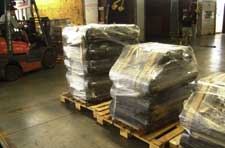Business Inventories, Industrial Production Both Decline
 |
(Michael James - Transport Topics) |
These reports are important to trucking companies because the manufacturing sector is their biggest customer group.
When business inventories are high, companies are forced to sell goods before ordering more from manufacturers and having them delivered to restock warehouses or stores. So, while an inventory adjustment is under way, it can distort normal flows of trucked freight until normal supply-demand patterns resume.
Business sales also fell 1.4% to $829.2 billion in June, DOC said. This is the largest drop in business sales since 1992. Sales had risen 9% in the previous month.
Sluggish sales are one reason analysts expect the Federal Reserve to lower interest rates when they meet Tuesday, according to Bloomberg.
The inventories-to-sales ratio, the number of months it would take to deplete existing inventory at current sales rates, was 1.43 in June, up from 1.42 in May.
That is especially important for dry van freight because when the ratio moves higher, it means companies will have to work down their current supplies on hand before having more goods shipped.
The drop 0.1% in industrial output was smaller than the expected 0.2% decline, according to BridgeNews.
The production of durable goods increased 2.5%, led by a jump of 4.7% in the production of automobiles, particularly light trucks.
Companies have been making job cuts in an effort maintain profitability. In July there were only 49,000 job cuts, while in the previous three months the total was over 100,000 in each month, according to BridgeNews.
7694

